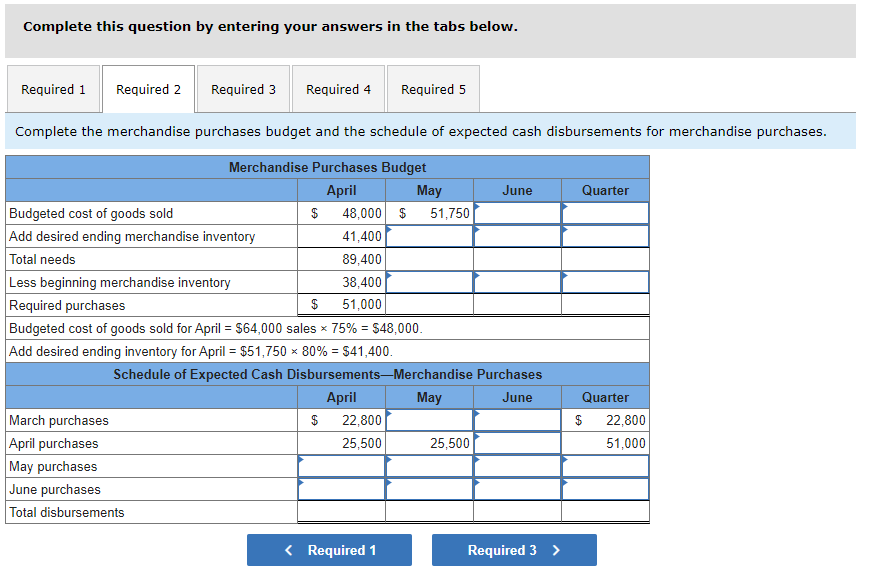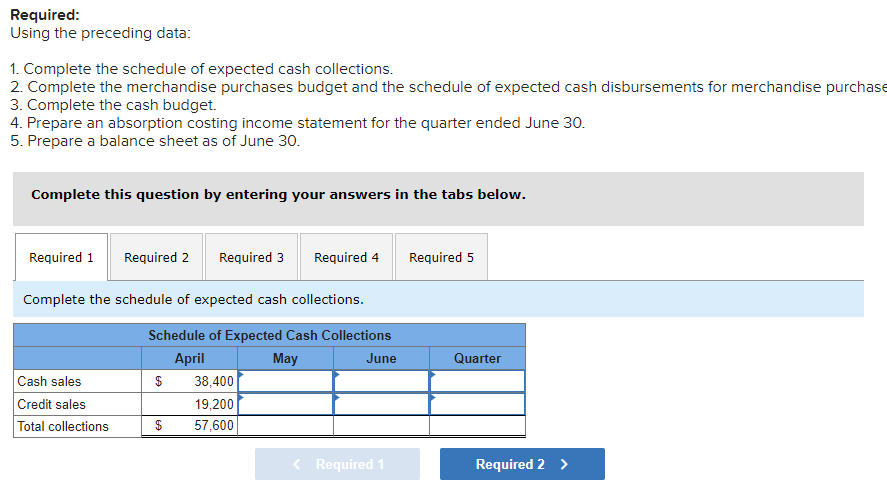The following data relate to the operations of Shilow Company, a wholesale distributor of consumer goods: Current assets as of March 31: Cash $ 7,300 Accounts receivable $ 19,200 Inventory $ 38,400 Building and equipment, net $ 124,800 Accounts payable $ 22,800 Common stock $ 150,000 Retained earnings $ 16,900 The gross margin is 25% of sales. Actual and budgeted sales data: March (actual) $ 48,000 April $ 64,000 May $ 69,000 June $ 94,000 July $ 45,000 Sales are 60% for cash and 40% on credit. Credit sales are collected in the month following sale. The accounts receivable at March 31 are a result of March credit sales. Each month’s ending inventory should equal 80% of the following month’s budgeted cost of goods sold. One-half of a month’s inventory purchases is paid for in the month of purchase; the other half is paid for in the following month. The accounts payable at March 31 are the result of March purchases of inventory. Monthly expenses are as follows: commissions, 12% of sales; rent, $2,100 per month; other expenses (excluding depreciation), 6% of sales. Assume that these expenses are paid monthly. Depreciation is $936 per month (includes depreciation on new assets). Equipment costing $1,300 will be purchased for cash in April. Management would like to maintain a minimum cash balance of at least $4,000 at the end of each month. The company has an agreement with a local bank that allows the company to borrow in increments of $1,000 at the beginning of each month, up to a total loan balance of $20,000. The interest rate on these loans is 1% per month and for simplicity we will assume that interest is not compounded. The company would, as far as it is able, repay the loan plus accumulated interest at the end of the quarter. Required: Using the preceding data: 1. Complete the schedule of expected cash collections. 2. Complete the merchandise purchases budget and the schedule of expected cash disbursements for merchandise purchases. 3. Complete the cash budget.
Please answer the first 3 parts - req 1, 2 and 3 according to the images attached
Problem 8-29 (Algo) Completing a Master Budget [LO8-2, LO8-4, LO8-7, LO8-8, LO8-9, LO8-10]
The following data relate to the operations of Shilow Company, a wholesale distributor of consumer goods:
| Current assets as of March 31: | |
|---|---|
| Cash | $ 7,300 |
| Accounts receivable | $ 19,200 |
| Inventory | $ 38,400 |
| Building and equipment, net | $ 124,800 |
| Accounts payable | $ 22,800 |
| Common stock | $ 150,000 |
| $ 16,900 |
-
The gross margin is 25% of sales.
-
Actual and budgeted sales data:
| March (actual) | $ 48,000 |
|---|---|
| April | $ 64,000 |
| May | $ 69,000 |
| June | $ 94,000 |
| July | $ 45,000 |
-
Sales are 60% for cash and 40% on credit. Credit sales are collected in the month following sale. The accounts receivable at March 31 are a result of March credit sales.
-
Each month’s ending inventory should equal 80% of the following month’s budgeted cost of goods sold.
-
One-half of a month’s inventory purchases is paid for in the month of purchase; the other half is paid for in the following month. The accounts payable at March 31 are the result of March purchases of inventory.
-
Monthly expenses are as follows: commissions, 12% of sales; rent, $2,100 per month; other expenses (excluding
depreciation ), 6% of sales. Assume that these expenses are paid monthly. Depreciation is $936 per month (includes depreciation on new assets). -
Equipment costing $1,300 will be purchased for cash in April.
-
Management would like to maintain a minimum cash balance of at least $4,000 at the end of each month. The company has an agreement with a local bank that allows the company to borrow in increments of $1,000 at the beginning of each month, up to a total loan balance of $20,000. The interest rate on these loans is 1% per month and for simplicity we will assume that interest is not compounded. The company would, as far as it is able, repay the loan plus accumulated interest at the end of the quarter.
Required:
Using the preceding data:
1. Complete the schedule of expected cash collections.
2. Complete the merchandise purchases budget and the schedule of expected cash disbursements for merchandise purchases.
3. Complete the
4. Prepare an absorption costing income statement for the quarter ended June 30.
5. Prepare a balance sheet as of June 30.
Complete the cash budget. (Cash deficiency, repayments and interest should be indicated by a minus sign.)
|
|
| Req #3 | |||||||||||||||||||||||||||||||||||||||||||||||||||||||||||||||||||||||||||||||||
|


Trending now
This is a popular solution!
Step by step
Solved in 4 steps with 3 images


